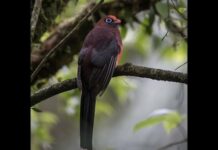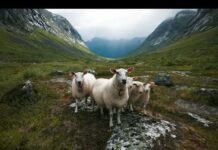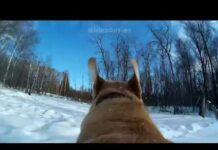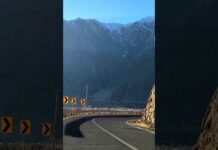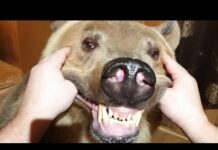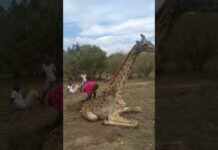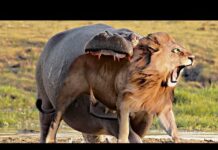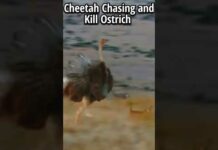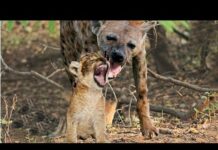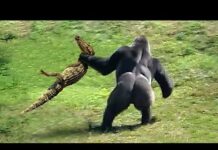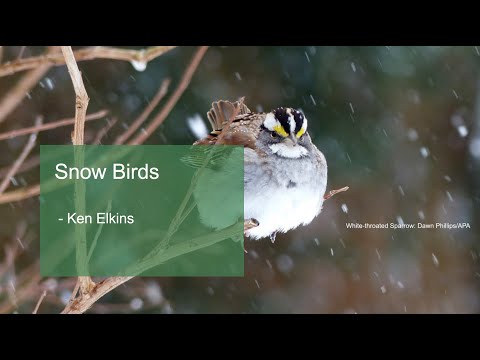Not all birds head south for the winter. Ken Elkins will take a look and listen to the birds that thrive in our cold, snowy New England winters.
That way um the first thing we'd like to do is uh do our land acknowledgement monunkatuk wishes to honor the indigenous communities native to the chapter area including the gusset weapon yak tatakit nunkatuk and ham and asset people.
As we advocate for conservation of the land and its wildlife we're indebted to the work of native and indigenous people who cherish the land for thousands of years before european colonization uh so we've got ken elkins tonight uh with snowbirds.
Ken's the community conservation manager at audubon connecticut where he oversees bird-friendly communities program which includes schoolyard habitat urban oasis and bird safe building programs he's been a long time partner of.
Monochtox bird-friendly community work including our urban scapes native plant nursery he's been interested in birds since he was 10 years old just like me and he was watching birds at his grandmother's feeders in vermont where as i was.
Watching them at my grandfather's bird feeders in new haven and with that ken take it away thanks dennis didn't know we had that uh beginning of our birding careers uh we're so similar thank you all for uh joining me tonight i i did not realize uh when dennis and i.
Thought about scheduling us out that it would be so extremely timely to talk about how birds are able to cope with uh the cold and uh tonight we're going to talk about in a few different ways here's a picture of me that's a little bit better than the actual in uh in video frame of me tonight that i do.
Have a background in the snow from the audubon center bend to the river where i'm based tonight i will be taking a break part way through for questions and one of the wonderful things about zoom thank you for introducing in the chat where some of you are from and i've scanned a little.
Bit the participant list recognize many of your names but since i don't recognize many of you um i want to just share that with zoom you can type in a question at any point rather than forgetting that question by the end of our time together after 45 minutes or so type it in right away and there will be a break and if you.
Definitely want to ask it uh you can make sure that you in the chat find dennis's name at the top as a host typing it to me might uh get missed because i'll be trying to focus on remembering what i would like to share with you tonight and wait for those questions to come ottoman connecticut and audubon new york.
Are uh regionalizing our efforts so we now have not just the monogata audubon society and our audubon connecticut offices but we have the resources and the knowledge and the ability to share with our uh colleagues in audubon new york all those dark dots with a are points with a white center or autobahn.
Chapters so menon can talk audubon being in the new haven area we also have to the east the photopog audubon uh and then those orange dots are our audubon centers audubon greenwich down there in the southwest part of the state being the first audubon education center in the country started in 1942 i believe uh that blue uh.
Circle there with the shorebird in it represents that we also have a sanctuary on the uh in guilford that has upland and also salt marsh habitat where uh if you come back on the february 8th meeting in particular you'll hear about some of the projects.
Going on that are stewarding that site but also using that for research of how our salt marshes are adapting to sea level rise and our green dots are where we have offices for all their colleagues to be close to legislators and all but uh.
Not only individuals but different community groups learn how they can be more bird friendly in ways like growing more native plants we work with over a dozen schools just in new haven and almost 50 across connecticut on having schoolyard habitats and uh we are also.
Starting to support other efforts like the yale divinity school had started a lights out campaign on campus and hopefully you'll be able to move across to other parts of the city of new haven for the spring migration i'm based at the audubon center bed to the river it's just a mile off of.
Interstate 84 so uh even for those of you not in connecticut uh coming through connecticut you can easily stop off to get to visit where we have 15 miles of trails it's open every day uh sunrise to sunset and our historic barn built at the end of the civil war era is the number one spot that people.
Are interested in visiting and uh also getting to interact with staff there and right below what you can see part of our demonstration gardens where we have uh plants not only attracting birds but also butterflies there are some people who might argue the bent to the river biologically might be better for.
Butterflies than even more birds uh even though it is one of audubon's important bird areas so tonight we're gonna discuss how birds are coping with the cold around us having some of the coldest air in connecticut we've had in uh over four years and it's gone across part of the uh upper midwest the past.
Few days birds were gonna share how they have natural insulation they also are able to adapt by staying more active and to stay more active they also need to be able to eat more and they also are.
Going to have a unique way that they can sit on the ice or on the branches that they are not losing extra heat through their feet is an interesting uh way that their blood circulates so that they minimize that loss of heat that they have so first when it comes to insulation even our backyard birds like morning.
Doves and chickadees and the sparrows have uh some of them will grow extra feathers in a in their foam mold that will give them a thicker protection from the winter they also can uh.
Improve that insulation by adding that oil from their your arpeggio gland so when they are preening they are adding uh an extra layer of waterproofing which also acts as you know on your own boots helps with a little bit of insulation on your feet even other birds have very specific feathers.
For insulating them from the cold penguins actually have four different types of feathers and they also have special blood feathers blood vessels that keep their bare feet from freezing you'll also notice on days like today that the birds fluff out and while we might instantly think of them as.
Being extra cold or feeling the cold that's actually adaptations so that they're creating more air pockets so that there is insulation by having those tiny little pockets of air around them think about when we add feathers to our coats it's tiny little air pockets in there in our down jackets and vests.
Is that same effect that they're having and they're able to control that so they might look a little bit fatter and puffier but it is uh instead of transferring that and mentally thinking that they're colder you should be thinking that they're actually a little bit toastier by having that effect with their feathers.
You might also notice the waterfall when you go to beaver pond's park in new haven or wherever you might be because it looks like we've got people from many different states and including some friends in canada i saw listed in the chat box a moment ago you'll see a lot of the ducks in particular tucking their head in.
Underneath their wing and by tucking their bills in it is not only a form of protection and shielding them but also they're able to breathe and recirculate warmed air from their own body heat and that is um going to help them in their lungs so.
That they don't lose as much heat for by breathing in too cold of air either so it's amazing how they're able to conserve that energy and while they have all that ice around them that's all just building up and being more insulation and this bird is actually conserving a lot of energy this way.
We might also notice on sunnier days during the winter that many birds are taking advantage of solar heat i know that the pets inside my house seem to be able to magically move without me noticing them that they stay in the sunlight in finding the window through mornings like.
Today and the birds are doing the same thing that you might also notice that they've drooped their wings a little bit or their tail might be spread out that they're trying to absorb as much of that solar energy as possible for heat you'll also notice that they might turn their backs to the sun get their largest surface of their body facing that heat.
And they might raise their feathers slightly so that their their skin actually is able to um have that uh heat uh absorbed onto their bodies even more efficiently and then move those feathers back in place to insulate them when they need to this here's a short-year owl doing that effect and you can just read it in this bird's.
Mind this food is all mine and blue jays and other birds will cash nuts uh and other food sources so that they can find it during the winter um and have that extra sources of energy during the winter uh that their metabolism has to increase they have to be more active if they're staying in a colder environment for the winter and to do.
That they just need to eat more calories blue jays in particular i put on the slide here because um we found that at least 11 species of oaks are actually dependent upon blue jays to move their acorns so that the trees can spread out and repopulate other areas of the younger forests um.
And that uh some blue jays have been found to move acorns up to two and a half miles from the original source one study followed a group of 50 blue jays and in just one month they moved over 150 000 acorns from just 50 birds.
On the coldest of days birds are looking for foods with the highest in calories which we could do the same thing on days like today huh that they're either looking for lots of sugars or lots of fats or in some cases lots of fiber berries also have lots of antioxidants and that's going to help.
Their bodies with the stresses of cold and migration and things but they're uh in particular looking for those of the high sugar content like these winter berries or they're looking for uh things like uh bayberry has nearly fifty percent of its calorie content coming from fats.
Fiber sounds like a funny idea but one of the birds that is able to gather lots of calories from carbohydrates like that is the roughed grouse and rough grouse also have an interesting feeding schedule during the winter being a bird that.
Well you might flush one and think they're very very quick off the wing they certainly sound like it with their sat with their wing beads um they're very prone to predation from other large hawks like gas hawks or from large mammals so they spend most of the day.
Roosting in a way that is camouflaged and hiding from others but they can go out at dawn and dusk and then they will feed for 15 to 20 minutes maybe half an hour and grab as many buds off of the end of the tree.
And it will be able to support them for overnight or for most of the day if this is the daybreak uh feeding at dawn and while it doesn't seem like a great investment in time they're able to store that food in their first of two stomachs that birds all have two.
Stomachs and the first one being the crop is more of a pouch like um extension of their esophagus so it's more of a storage container than is digesting and they're able to then slowly release it out of their large crop and then into their gizzard which.
Is the part of the stomach we think of um which is going to digest that and turn it into energy for them another form of insulation is fat and birds do get a layer of fat on their bodies we just don't notice it and it's not over extreme because they do still have to be able to fly.
Uh but we can see here the bird on the left you can see pink just muscle on their heel here that uh sometimes bird banders when we are collecting them in a net we can blow on their bellies and see if they have a brood patch during the breeding season is what you're probably seeing with this.
Bird on the left and then this red breasted nut hatch on the right we can see was probably preparing for the winter or more likely for migration has this very rich yellow golden color of fat reserves uh right underneath their skin and that does act as insulation for them just like with us so to maintain a metabolism level that's.
Keeping their bodies warm their body temperature is actually slightly higher than ours chickadees and some other songbirds have been found to eat up to 20 times more during the day in the winter than a similar day length in the summer um so chickadees in particular will travel.
In groups and that is for help them with finding food that they can take turns on who is actually searching for food and who is on the lookout for predators a bit more so safety in numbers but also uh they're very curious beings and they're able to take turns in uh exploring where they're finding food.
That there's a lot of trial and error earlier in the winter and then as they are able to find great pockets uh and caches of food then foraging chickadees um can uh remember those sites much better than others and they're looking for a lot of different food sources certainly we see.
Them by our feeders and eating lots of sunflower seeds or suet but they're really spending most of their day away from a feeder and finding things like seeds but also spiders or spider eggs hiding in the uncut wildflowers in your yard uh or in a in the fields nearby and then in the.
Forest they're going through the trunk of the tree and in the edges of the branches uh gleaning still where there are some insects that are overwintering or their pupa stage in particular is how a lot of insects over winter in our area and that's what they're looking for having the ability to find food and especially during a snow storm or.
Something chickadees are actually able to discard old cells in the fall that hold last year's locations of food stores and in the fall they're actually able to grow new cells to form new fresh memories of where this year's food stores are.
So scientists are studying chickadees and a few other uh overwintering bird species to see how this ability of a bird's brain to generate new neurons might actually help us uncover ways to replace our own brain cells lost from injuries or strokes or other forms of degeneration uh from like parkinson's or.
Alzheimer's so uh as i've read more and more about chickadees than some of our other uh bird brains maybe we should uh reconsider how we use that frame phrase bird brain some other birds if you hear chickadees outside i know you've seen them plenty.
Of times and i have two but especially as i just finished up christmas bird count season every time i heard a couple of chickadees i stopped and i double checked who was with the chickadees that it wasn't just one or two chickadees by themselves that they quite often are in feeding flocks of mixed species that.
There's almost certainly going to be a couple of their cousins the tufted tip mice nearby also very often following them would be golden crown kinglets slightly smaller even than a chickadee and that beak is so small they can't eat many seeds and they're much more adapted for eating.
Insects and even when it comes to eating insects they can't eat many larger food items like silk moth cocoons um from a sacropia moth or something is just way too big for them to even pull apart so kinglets have become amazingly efficient at searching and finding smaller insects.
And they do amazingly well at doing it on evergreen trees spruces and furs and pine trees in particular unlike their the chick kitties that they look like golden crown kinglets do not go into cavities in the evening either that one of the other uh strategies we'll talk about in a.
Minute for surviving overnight is roosting in groups but instead uh kinglets might actually uh clump together say three or four birds on one branch huddle all together head and tail out so that they're folded in as close together all in one twig.
And this is uh one of the amazing ways that they are able to keep warm through the winter other birds you might see in a feeding flock with the chickadees or things like white breasted nut hatches maybe a brown creeper.
And certainly a woodpecker or two usually downey or hairy but also more commonly we're finding red-bellied woodpeckers spending the winter you know that 25-30 years ago finding a red-bellied woodpecker here in the northeast during the winter was actually pretty difficult it's one of the birds on our christmas.
Bird counts that increased the most over say the last 25 to 30 years woodpeckers are one of the species that might roost overnight in a cavity but rather than reusing their nest cavities we're finding that many woodpeckers will actually build a new roost hole just for the winter so uh it's a behavior that we have to.
Watch what time of year it is and it's not early nesting but instead it's an adaptation for winter it's amazing during some of our snowstorms that we can see the snow actually accumulating on top of the bird and it's a great illustration of the power of insulation that their feathers are able to keep the warm.
Inside their bodies and the cold on the outside what we can see happening here is one of the other adaptations for birds is that they can actually shiver it's not like us where our teeth are chattering and our whole bodies might move a little bit but instead their muscles are.
Contracting at a very fast but small uh uh amount of movement but just very fast almost like if you get some of that uh electric stim from the um physical therapy or uh um or other doctors that if you have that you it's very similar just the muscles.
Contracting very fast but that is one way that they're able to increase their metabolism which is then gonna help improve the amount of heat their body is generating when you see the snow forming on them it's really tough to imagine them actually shivering so a few years ago when i first did some.
Of this research it there was a very famous winter resident in central park this mandarin duck had found its way there in the park and it brought up a discussion as well of how can the ducks and the geese and the gulls all stand on the snow or on the ice without freezing.
And i still question how this photographer was able to get this photo but i'm a bit jealous uh that this was a gull sitting on ice and we can see the blood vessels in between their toes how does the burden not lose all of its body heat.
It's because of the blood vessels actually in their legs that are so closely positioned together that the warm the blood that is warmed from their body is coming down through their artery into their leg and the vein is bringing.
Up out of their foot cooled blood from their very cold foot and in the middle of their leg there's a heat exchange there so that way the warmer blood in their artery is warming up that cold blood in their veins so it isn't super cooled and it isn't shocking their main body as.
Much and it is cooling off the blood so it's not getting to the foot as warm but that also makes it so that the ice isn't melting and they aren't freezing themselves to the to the surface as well so they end up with very little heat loss in their foot but it's just enough that it's staying above freezing which.
Is the most important part and that their main body is then able to maintain their body heat better we don't have this very often in new england and i somebody might correct me that there has actually been a overwintering hummingbird somewhere in the northeast other years we have had this happen but.
Especially in places like desert southwest of arizona into new mexico there are some hummingbirds and i've heard up the pacific northwest this year there's a couple of surprise hummingbirds hanging out in washington state and on colder nights what hummingbirds and some other smaller species including kinglets can.
Do is that they can have a very short period of reducing their body temperature and their um overall metabolism so that their.
Blood uh their pulse rate drops and this is a process called torpor torpor is not too common though in winter birds because it is slowed down their processes so much that it can drop their body temperature by 22 degrees so if there is a bit of a.
Gamble but it also can be enough to help conserve them uh their overall energy to be able to survive but if you've dropped your heart rate and your body temperature by that much uh in a form of regulated hypothermia by dropping all of that you also they.
Need to rebuild the system and it's not something that you could just turn on that switch so for a period of time in the morning after a state of torpor the birds need to wake up again and for some of us we might be able to relate it to a really bad hangover it's going to take a while for.
Them to wake up again and have all of their faculties about them that this is a time that they'd be more vulnerable to predators so chickadees hummingbirds some swifts can do it in certain conditions but it is not a behavior that many birds.
Do and they don't do it as often as people might think what many birds do more than we realize is that they are roosting together overnight to maintain body temperature together and some birds if birds will nest in cavities they are a species that will certainly roost overnight in cavities.
Together so tree swallows in some cases uh if during worst conditions but certainly over wintering we have bluebirds in our area and for years i've been a christmas bird count compiler and we would have two to 300 or more bluebirds in our christmas bird.
Count circle in western connecticut but as we were reviewing with different observers during the day nobody was seeing more than eight and some in or at maximum 12 bluebirds in one group we would see eight here and six there and four in the next field and then we realized that's pretty much the maximum number 28 to 12 being the.
Maximum number of bluebirds you can fit into the clown car that is the bluebird box at night so uh that's the maximum number that could roost together i have in the recent years seen 30 but it was also an area that had many bluebird boxes in view so they could be roosting together in separate boxes.
One reason why i chose the name snowbirds for the title of this program is that when i think about my beginnings in studying birds it was the nickname snowbird is how i learned to identify this bird on the screen most of us now know it as the dark god.
Junko but that was the nickname that my grandmother gave to me because it was a bird that would arrive in central connecticut uh about this time of the first snows was one way that we can learn it junkos are a great example of snowbirds a bird that.
We get to watch at our feeders during the winter and get to see all their interesting behaviors those white outer tail feathers coming out as a form of non-verbal communication junkos are another great species that we've learned a lot that they have in their fall malt they grow extra.
Winter feathers so that coat of feathers is usually 30 heavier than the spring mold uh for feathers that they're gonna have during the summer excuse me and we've learned over the years that while many birds have changed their timing for migration junkos are one of.
The species that their migration hasn't changed all that much related to temperatures it's still much more related to daylight than it is to overall temperatures around them jungles are also one of those questions that we get so is that the same bird visiting my feeder year after year.
And i've learned that while some of our sunbirds might only have an average lifespan of two to three or four years like tufted tip mice or song sparrows others like white threaded sparrows and junkos we're learning that the oldest ones from bird banding are.
11 years old for junkos and 14 years old for white-throated sparrow but their average lifespan is actually longer than some of our other songbirds so it is one that i could say well year after year you may possibly have the same ones returning i've seen the chat box blink a few times the last little bit so uh dennis do we.
Have many questions yet a few quick questions we have a few questions ken uh richard asks who counted 50 150 000 acorns there are many academics in the group they're all chuckling right now some.
Poor grad students who were working their way to uh having their own individual projects and some undergrad research assistants were most likely the ones to have to observe that i've seen other ridiculous wildlife biology research where somebody learned that on average a.
Chipmunk can carry at least 30 beech nuts in their pouches at once and their caches underground have usually on average a thousand beach nuts for the winter okay and robert asked about berries do birds have a preferred berry type or color i've noticed that.
Robins come through early winter and eat all the red holly berries in the yard but leave the orange choke berries ah so birds can't see colors that mammals can't so um the plants actually are.
Baiting the birds by having more colorful fruit so you're right uh reds and oranges are going to be more preferred than a yellow and we all i've also seen uh sadly the non-native blue porcelain berry is very attractive to birds in the fall um beauty berry being more native to the mid-atlantic and southeast than.
Uh those of us in the northeast that purple color is also really attractive um interesting here they didn't want the choke berry there are mixed results now of some of the berries have more concentrated sugars after they've frozen.
And thawed a few times um there's some research to disprove some of that for some of the species of berries but they do have a preference for viburnums and dogwoods first and then things like the hollies and the winterberry are going to persist later into the winter and then things like.
Bayberry are going to persist even longer than the others that's interesting too that my holly berries persist all winter and it's the the first spring arriving flocks of robins that uh take care of them um yeah it's it it it's kind of very.
Localized as to when a group of birds will decide which of those fruits they want next laurie asks do you happen to know what the average life span is for a cardinal no i looked at white throated sparrow and a couple of others i think of being near.
White-throated sparrows today and i actually learned that some of the longest lifespans were longer than i had last learned to them like tip mouse i had always had my head about eight to nine years and now i learned it was um well over 11 years.
Um today but i did not look at cardinal itself um as one of those i was for anybody interested i just typed in uh longest living in the name of the bird and google actually popped it up in bold so it's learning very quickly how to search through places like uh.
All about birds.org and get that information out on the front very quickly and allison asks how much water do birds need daily oh uh not a lot and i will talk a little bit about it of how we how it's best to.
Serve it uh we'll be at the end when i talk about how we can help birds through the winter um but i'm not a physiology person to know that they need an ounce of water or something like that and then uh last question we have here right now is april asks.
Is there any information on the best spots to see red-breasted nut hatches in connecticut or rhode island uh red-breasted nut hatches are an eruptive species which means that they show there are more of them some winters than others because most of them are breeding north of us especially into canada and very northern new england and.
They come down here to southern new england when they've run out of when there is poor cone crops up north and this is not a winter we're seeing many of them um but there are some and when we do find them it's almost six it's very likely going to be in.
Uh a planted evergreen plantation whether it's norway spruce or like white pines are going to be areas that you're going to find them more i i know that there was one hanging out in november into early december at the bent.
Of the river in hemlocks so other evergreens it happens but if i'm really looking for them i'm going to go to one of the entrances to a state forest with those plantations of larger evergreens because there's bigger cone crops in those so it's usually every two to three years so hopefully we'll get to see more of.
Them in another year or two down here in southern england then uh uh i'm going to ask uh cynthia to uh unmute herself and she's got her hand raised so unmute yourself and ask your question or not i guess not ken.
So carry on thank you great so we were talking about berries that birds eat for the winter and uh there are some species of birds that specialize in particular the wax wings being a group that people instantly think of as being fruit eaters there is one hazard though of.
Having that as your number one food source is that the fruit left over in the winter has been around a while and we know when fruit has sat around for a while it can often ferment and the birds then may uh consume that.
And there are signs that sometimes yes the birds outside are a bit drunk uh sometimes you'll see them drooling off to the side uh there have been a couple of cases over the years where the birds have been uh that has made the news one was up in the minneapolis area a few years ago.
Where one person collected many birds and then of course they got the syntax as they got put into the news article didn't go off so well because it was a photo of someone with a bunch of birds on the front seat and they were taking the bird to rehab so the phrasing there was a little bit off but you get the idea.
So uh usually it's not that harmful sometimes you wonder whether birds actually do like that idea but most of the fruit are actually quite resourceful for the birds and they do need it other birds that are eating fruit during the winter.
Are american robins we always hear as kids that the robins fly south for the winter but we have uh i believe a couple thousand of them at least in connecticut this winter if not some years over ten thousand uh combined on our christmas bird counts and they are uh eating.
A variety of different fruits when they can't reach to the insects on the ground they do not eat a lot of worms all the time they are eating other food sources and great places to find them and notice these fruit eaters are to watch where the crab apple trees are in your downtown areas even in the rural.
Towns outside the post office or the bank or quite often uh hawthorns and crabapples are great persistent fruit to find them for the winter also of course hollies if they are growing in your neighborhood can uh be a great magnet to get to see those robins.
If you happen to be someone who really loves watching american robins you might notice the robins you see now in your neighborhoods are slightly larger and darker overall than the robins you might see in late march and early april in uh running around on the lawn that they are most likely uh species uh.
They are robins that nested in northeastern canada and they consider connecticut and southern new england to be south for the winter some others if we're lucky enough this doesn't seem to be a winter lining up but every so often for uh us in southern new england we get to see pine gross beaks eating on those uh.
Persistent winter fruits our friends who are checking in tonight from montreal and from uh the ontario areas they might get to see them just about every winter visiting their neighborhoods others that are eruptive and that's an irr up uh it's how it's spelled.
Is uh meaning that they will migrate south when food sources require it pine siskin is a cousin of the american goldfinch you can see just that little bit of yellow in the wings there and that same very thin conical beak another cousin of theirs is of the.
Small finches is the red poles and the males have a beautiful rosy belly color and they all have that red cap on top and a very small pointy yellow beak with a little bit of a black mask around it they will come and eat at the same foods that you provide for gold finches uh like the.
Niger seed representing thistles millet that might be on the ground for the junkos and uh in our nearby parks watching for the older shrubs that those seed clusters on alders and birches are their natural food sources that they would be looking for to the north and they're.
Going to try and their their brains have kind of a pattern recognize that in the distance and you'll find them in the tops of black birches and in our elders here another finch primarily from the north are the cross bills here are some right wing cross.
Builds and you can see those long bills are slightly curved over you can see it much better on the face of this crossbill that their peaks do not align up to be perfectly closed but instead by having that curved appearance and uh that alignment they're able to.
Reach into the very fine scales of spruce cones and be able to pull the seeds out at the base of each of those if we think of some other birds out during this winter time uh.
The you may notice in the evenings in early in the mornings one of the most vocal birds this time of year are the great horned owls and that is because great horned owls uh just about everywhere in the range are the earliest breeding bird in that area.
That owls none of them are great at building nests they usually will find some space that qualifies as safe for their eggs uh quite often a nest of something else or i've seen them on just bridge abutments um and in other spots they'll even use an old squirrel nest which might be too.
Small for them but it's what they found and great horned owls are uh breeding early so that they are out and raising their young before the other birds the prey is one of their strategies but to do that that means that they may be incubating eggs.
During the coldest weeks of the year and also with snow accumulating on top of them that they are uh courting in november and december in a lot of their range laying eggs in january and then it is 28 to 32 days for.
Most large birds of prey to incubate so that they are uh hatching by the end of february and those young are then still in some cases with snow around them and able to fledge usually by the end april early may at the latest.
Because it's a good six to eight weeks before they're able to really fly off the nest another bird we think of getting to see during these colder months are bald eagles uh that many of them are breeding to the north although we have more and more who are finding ways of breeding in suburbia.
And even in urban areas there are more of them visiting populated areas during the winter because their food sources of fish are frozen over in those bodies of water so they are finding their way to.
Uh coastal areas and near hydroelectric dams are where they are able to find food much more easily and i have to say after leading many many tours to see bald eagles and observation days the colder and uh more blustery it is for us and unpleasant it is outdoors are the days.
That we're gonna get to see more bald eagles places in connecticut to get to see quite a few the lower connecticut river valley in many years has been one of the largest overwintering populations of bald eagles uh places south like the chesapeake bay or um.
Near hydroelectric dams so we have in connecticut the chipog dam and monaka tuck is uh organizing a trip for people to get to visit the viewing uh station there to get to see the bald eagles at a proper distance uh and possibly be able to take photos usually uh places like that also chipog.
Dam has an education program so there'll be some uh injured birds of parade that will be there as educational ambassadors that day and also some good bird watching nearby as well for most of us it's only during the winter we get to see some other birds of.
Prey be active uh birds that tend to be in more open country that we don't get to see like this rough legged hawk here it is very similar to a red-tailed hawk in size but you can see that there's a much darker area on the lower belly and they have a big white band in the base of their tail two key field marks different than a.
Red-tailed hog and sometimes we don't get to see the bird of prey but we can tell they've been nearby large accumulations with fluffy snow the owls in particular can hear the prey under the snow.
And they will be able to uh fly down and hit their prey with their talons without actually seeing the mouse under the snow and we get to see amazing um views like this of just the print of the wings and an impression of part of their body hitting the ground and.
Flying away with whatever prey item that was underneath and in some cases under your feeders we do end up with things like cooper's hawks catching a morning dove where this looks more like it was probably a pigeon by those feathers it's my guess it doesn't look feathers don't look big enough for.
Canada goose but i could be corrected seeing these imprints in the snow makes me think about the title of tonight's program again is snow so in the chat box i'm going to open up the chat here myself so i can see uh what are some other birds you can think of that have the word snow in their.
Names what are some birds with snow in the name of the bird so we have quite a few people have the same first inclination as i do the snowy owl uh for those of us in southern new england.
And if you're in the boston area you almost annually get to see a snowy owl this year we've had a fair number of them in our area and i've heard them down through new jersey this year as well my sister in the denver area looked into getting to see one in her neighborhood a couple years ago so they do spread out a.
Lot oops i didn't want to do that yet only a few people will guess that one i do see a lot of other people guessed snow geese yes and they are quite numerous i have friends birding in arkansas right now and they saw very large uh groups of snow geese overwintering.
Together and it's pretty amazing how the birds will come down the hudson river the snow geese in particular and very few of them make it in just east into connecticut we also have a few people who mentioned a third species the snow buntings and they're a songbird that.
Nests to our north quite a bit and will often be found in feeding flocks uh one spot if you're in connecticut that you might get to see feeding flocks of them is stratford point a few years ago after a great snowstorm they were roosting during the day on the roof of.
The building the office building there at stratford point we also have a guest for snowy egret yes uh the all-white appearance of the snowy egret getting the name snow in its name and those little yellow slippers to distinguish it from.
Its larger cousin the great egret ah sharon mentioning snow and that is one that i didn't think about when i made this you're right and i just had somebody asking me about how did they get to go see the himalayan snow that are naturalized to a a couple of mountains in nevada.
Is one um nobody guessed the snowy pigeon no there really isn't one i just happened to find a photo of an all-white one on the snow uh there's a few other birds that have snow in their name as well there's.
Snowy plover our cousins of our you know for us in connecticut the um piping plover these are native to the nest more in the pacific coast and i also just for giggles had put in a snow.
Petrol is from antarctica primarily uh but there are other birds across the uh globe that also gets snow in their name because that all white appearance great so going through birds with snow in their names one last section i want to share about tonight are.
Now that we know how birds are able to survive the winter is there anything we know about them that we could help them out a bit more and i did start to notice and uh we'll address those in a few minutes of questions or things about how do we feed the birds and support them with proper food.
Sources having native plants is definitely a certain way of doing it as we mentioned earlier they need to keep their metabolism high so they need foods that are higher in fats and you'll notice the birds will actually choose certain foods off of the feeders you.
Might consider it and place it as a human characteristic as being picky their bodies know what they need so they will uh they will be more attracted to the black oil sunflower seeds on this block of food because it has the highest fat content of any of those seeds.
And sadly uh the cheaper the feed source but those little red berries on there the red milo are really just fill and even house sparrows don't tend to want to feed that as much either corn is higher in carbohydrates but really during the winter the birds are looking for higher fat sources so the.
Sunflower seeds are the best way to go and if you want to have one source and make it simpler on yourselves we had to do this because uh training volunteers to fill our different feeders with different types of food was too complicated going with black oil sunflower or hold.
Sunflower seeds which is the black oil without the holes and the shells on them is the best bang for your buck that you are getting um a food source that is high enough in fat content and attractive to cardinals and blue jays uh yet small enough for chickadees and.
Goldfinches to be able to get their beaks around it to be able to feed on it so black oil sunflower is the number one easiest food source to think of for feeding them in the winter for a bird feeder having the different plants and i shared back in the late fall was how to attract birds through.
The seasons is having different native plants that are going to have those food sources available for them during the winter and having uh not a plant that most people think of for gardening purposes but allowing them to grow where they volunteered things like the staghorn sumac have um berries that persist and will be a.
Great food source later uh in the winter but also the birds may find bonuses of protein sources like spiders and other insects trying to overwinter inside those berries uh makes this a um a double winner for them you know that they get more than one food source in.
From one plant someone else asked about water and it doesn't take a lot but birds need to not only drink the water but for their feathers to stay healthy and uh to maintain that insulation qualities of their feathers they do need to bathe and to do that they need fresh water so.
Many people are able to have water sources that are close enough to the house that they can have an electrical source and have a heated bird bath whether it's in the whole base or like this one they inserted something it's not making a hot tub for the birds.
Instead it is keeping the water above freezing so it's somewhere around 35 to 37 degrees in that water so it doesn't freeze um but the birds do need it for drinking but also for that bathing in particular is critical for them it's a little late in the season to think about this but uh a note to take.
If you really want to help the birds during the winter is uh be as lazy as possible with your fall cleanup in your yard nature likes things messy especially birds so they are going to be able to find extra roosting sites by finding that extra pile of brush in your backyard.
Uh rather than sending the christmas tree out to the corner for pickup putting it out in the backyard as an extra winter shelter site for storms and for the cold are great uh leaving materials in your nest boxes and leaving the old nests there until march are great ideas that they have some insulation through the.
Winter are great things as well also as you're choosing new plants some people are already dreaming of gardening for the spring think of make having evergreen trees or shrubs as a important cover for birds not just during a storm but many of them will over or roost roosting them overnight.
This year as we were starting that christmas bird count at the bent of the river we were in the parking lot greeting each other and we had a constant stream of morning doves coming out of this row of just eight or ten white pine trees they're only about 15 feet tall but they're just so dense with foliage.
Right now that they there were at least 40 morning doves over uh spending the night in those pine trees and supporting your local conservation groups wherever you might be whether it's your local autobahn chapters who might be maintaining habitats for birds and land trusts audubon is working across our network with more and more.
Land trusts on helping support them uh because they are great at um preserving open spaces in your community uh and they're all trying to work on improving their capacity for uh improving habitat and in some cases uh audubon is able to support them and how they're able to maintain those spaces for birds in different ways.
So uh finding wherever that local ottoman chapter or center is and your local land trusts are two things that i would say would help winter birds a lot too so thank you all for your time tonight i hope i've gotten a spark a little bit and maybe you'll notice birds in the coming weeks a little bit differently as.
You get out and about uh and uh dennis i'm gonna take a sip of water here and uh if you have like to share a few more of those questions i have some more questions go ahead uh trying to.
Find out where i left off um morgan asks do birds who stick around in winter have more brown fat than white fat that is a question i can't answer um i'm much more of a field biologist in that um i usually can answer with authority like i know the answer but um.
If somebody else here is a little bit more of a bird physiologist would like to speak up um i'm more than willing to take that answer or if they want to put their name and their email into the chat box i will be happy to follow up later and there was a related question what's.
The um what's the best type of suet ah um suet so it itself any of the types are going to be higher.
In fat content and now having some that add in other pieces of insects or fruit those are all going to be able to help support more types of birds because you might notice carolina wrens and some.
Warblers will eat at suet more than just uh the nut hatches and woodpeckers that you might thought of eating it and that's because we can insert those other items so um it's not like black oil sunflower that i can think of one specific.
Seed type with suet i think creativity makes it uh even a bit more attractive to more birds okay um richard asks are there any infectious disease outbreaks affecting birds right now i'm not aware of any specific um outbreaks that are impacting feeding.
Birds with feeders we did have last summer an outbreak in the mid-atlantic and in the indiana ohio area in western pennsylvania um that was unknown as to what the true pathogen was um.
And there was also last winter at this time there was a problem on the west coast with um a pathogen that was going through birds and feeders so that's why switching and using native.
Plants is always going to be a safer bet for your birds if that is a concern for you but right now there's no direct impact on birds with any diseases that i'm aware of the one would be is there always some small outbreaks of for finches be aware that if you see.
Especially in house finches that it looks like their eyes are shut uh while they're at the feeder that is most likely a eye conjunctivitis and you need to clean your feeders and that's always a good idea is every one to two weeks maximum take it in for a day and a very light bleed solution of 10.
Bleach and just dunk it you can brush it all out if you want to make it look physically cleaner but disinfect it and let it air dry and that the gas the bleach will gas off and then they'll be safe for the birds again ryan wants to know what are the jungles doing under my thistle feeder ah they're eating the.
That niger seed that falls out of the thistle feeder on the ground that they spend over 50 of their foraging time on the ground rather than any elevated branches they were always looking for seeds or insects on the ground so they're uh taking advantage of the birds above them being messy and whatever seeds fall to the ground.
Lori in maine says we have many bald eagles why is there a stellar eagle nearby so unusual it is extremely unusual uh i had some a colleague today asking me uh a little bit of the why as well and we don't know the exact why but we know.
That many birds are have a tendency of vagrancy that they will um get off course and if they're a strong individual they might have a major navigation challenge like this stellar sea eagle should be somewhere in northeastern asia and instead has made its way from alaska.
To texas to um quebec and new brunswick and now to maine and massachusetts and back to maine um that this um this individual seems to be feeding well it's just really off course so there's no reason for humans to really challenge that or.
You know to change that we're not to fix the bird and maybe there's another the reason why it should be a part of the gene pool or it's also that there's other species that there have been big scouts like this that are out ahead of other movements by a population cattle egrets come to mind that thanks to how humans have changed habitats eager.
Cattle egrets can survive on just about every continent except antarctica and we didn't physically actually move them they just found their way to move their population along for the most part so maybe that might happen with sea eagles we're just seeing the first one that in another generation our grandkids.
Might see other stellar sea eagles in north america we don't know allison wants to know if safflower seeds are high in fat i need to look up to be sure what i do know is that safflower seed is not as desirable as black oil sunflower but um if it is the only seed you're using.
Because squirrels don't want to eat it and grackles and other birds that are less desirable at a feeder won't choose it either cardinals and chickadees and your other birds you want to see more we'll choose if it's the only one that's there.
Valerie asks about uh dryer lint she says i save it for the birds for insulation of their nest is that okay if you're using any sort of um scented products for washing or in your detergent or in a fabric or any.
Type of fabric softener then that lint is not safe for birds that those chemicals there are not safe so dryer lint is not one i usually recommend um instead it would be um fibers so when you're done brushing your hair or.
Your pet's hair you could put that out but not dryer lint uh let's see as the detectors drop will birds spend more time sheltering or feeding and moving about that's from morgan um.
It depends on the conditions you'll see on some stormy days the birds will hunker down but certain species will hunker down more than others like morning duffs will sit still and on a snowy day it's really tough for me to find them do on my counts but other birds like carolina wrens seem to be in chickadees seem to be just as active as.
Ever uh and being active is one of the major strategies for them to um stay um to keep their body temperature up so they staying active is a very natural behavior more so than hunkering down each wants to know.
If there's any fruit he or she says i put apple sauce on us on a stock but none seem to be interested um yeah apple's probably not as much i know during the spring grape jelly is quite.
Attractive and it seems ridiculous but the ones with it's the higher sugar content so i think there's something about apples themselves but they will eat crab apples but there's a different content it's also that it needs to be able to fit in their beak or soft enough for them to peck at it.
That most almost all of our native shrubs and small trees have a fruit size that is small enough for even a yellow-rumped warbler to put their beak around them the berry and eat it so think of that so blueberries might be actually more likely and attractive than.
Say apple slices would that is so friendly on your budget at the moment but um that would think about how the birds are able to eat it and that might lead you to what would be the correct answer richard from california wants to know are are birds.
Parasized by ticks or mosquitoes oh yes uh we know uh many bird species not just crows or blue jays were affected by west nile virus when it first came out but um many others have shown the antigens to it when we've been able to collect blood samples we have a lab at yale.
University in particular that looks at birds as a vector or just um they're are they being impacted by this some of the same diseases as us that are transmitted by ticks or mosquitoes and ticks certainly especially those that are staying low and in the brush.
Um in dense vegetation that we think of when we get ticks on us so common yellow throats song sparrows are birds that um do carry a lot of ticks um and they can be parasitized and it depends species by species and um tick-borne disease by disease as to.
How much they're affected but they do carry many species of ticks and um are bit by many but not all the same types of mosquitoes as us and uh h again we're in woodstock new york a bard owl was hanging around in our yard on two occasions that we saw it there were many birds feeding on the.
Feeders at the same time the owl wasn't fearful to the other birds i assume that it might prey on some birds but it didn't seem to care it watched them like they were entertaining but didn't seem to care.
Wow um i've seen many bard owls uh mobbed by feeder birds especially house finches if there were any bluebirds in the area they would have zero tolerance for that bard owl to be there and they would uh songbirds would turn in mob it um blue jays cardinals also um.
So maybe the bird the owl had come in quietly enough that the songbirds did not notice it um but the bard owl certainly would feed on anything cardinal sized and smaller than if i had the chance it's not as fast as a sharp shin hawk or a cooper's hawk so it's it's gonna have to use much.
More of an element of uh ambush to be able to catch them than those other hawks and then uh finally uh sharon opened up a little thread here in the chat about rodenticides and harm that they do to clocks and else.
Um i wish i had one of my colleagues from uh one of our rehabilitation centers like audubon sharon here to really uh point out the impact of rodenticides that um many of the professionally used.
Denticides are anticoagulant so it's going to make the uh rodent start to bleed internally so it's not going to die instantly but instead it's going to move around and look injured and that's an uh its behavior would be something the hulk or the owl would more likely predate on it than a healthy.
Mouse or rat um so we know places like around uh harvard hospital in hartford we've lost breeding populations of red-tailed hawks because they've had to use um profession in professional level rodenticides around the healthcare facility um.
And i saw somebody in the chat box did put in something about uh looking at raptors are the solution rats website is very wonderful for learning more about how to control rodents more naturally um and that would not be um a poison transferred to the hawks and owls that we love because instead.
Uh even wineries in california are looking to uh protect uh they're actually using owls and kestrels for control rather than chemicals now so um there was a question in the chat box about the photography and i do want.
To point out that um you did not see my name next to any of the photo credits but instead the apa here especially under the bluebird that is audubon photography awards that when people enter their photos into the audubon photography award sponsored by canon every year for the audubon magazine.
Uh there's an order of three to five thousand entries a year at least they uh sign off that bird their photos can be used for educational purposes within the audubon network so for our materials with school groups and uh for talks like this uh we are able to use it and that apa.
Has become kind of the accepted abbreviation rather than having to write out audubon photography awards i usually mention that much earlier in the talk and it slipped me today um so i apologize if any photographers were here uh watching but um thank you all and stop sharing.
Thank you so much ken yeah wow everyone's still here have a great night everyone yeah thank you and thank you everybody for joining us tonight the um next week we have uh a long island sound report card from.
Save the sound following week will be dam removals and fish past passage from save the sound
We are excited to present to you the captivating video titled “Snow Birds”. Get ready to embark on a journey of enjoyment, smiles, and laughter as you watch this delightful creation. “Snow Birds” is a perfect blend of entertainment and amusement, carefully crafted to bring joy to your day. From the moment you press play, you’ll be greeted with a cascade of lighthearted moments, heartwarming scenes, and perhaps even a few surprises that will tickle your funny bone.
Whether you’re in need of a quick pick-me-up or simply looking for some light-hearted entertainment, “Snow Birds” has you covered. The video promises to deliver a collection of moments that are bound to leave you grinning from ear to ear. With its engaging content and skillful presentation, “Snow Birds” is more than just a video – it’s an experience designed to brighten your mood and spread positivity.
The creators of “Snow Birds” have poured their creativity and dedication into crafting a visual treat that resonates with audiences of all ages. Through expert storytelling, impeccable timing, and an array of engaging content, “Snow Birds” promises to be an unforgettable journey that lingers in your memory long after the video concludes.
So sit back, relax, and prepare to be entertained as you dive into the world of “Snow Birds”. It’s a delightful video that aims to bring a dose of happiness to your day, leaving you with a lasting smile and a heart full of laughter.
This video was uploaded in youtube and has recieved 54 views so far. This is a great achievement and laso it has received 0 likes and .
Data bout the video:
Rating: ,
Video dimensions: 2d,
Video definition: hd,
Video duration: 01:14:49,
Video favourite count: 0
Video comment count: 0


